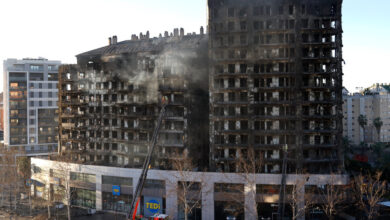
[ad_1]
Israeli troops on Thursday scoured the largest hospital in Gaza for a second day, searching for a Hamas presence or any evidence that the armed Palestinian group had used tunnels underneath it as a secret base, even as Israel came under increasing pressure from Western allies to curtail civilian deaths and ease the suffering of Gaza’s population.
Although the military has yet to present public documentation of a vast network of tunnels, an Israeli military spokesman, Rear Adm. Daniel Hagari, said troops had uncovered a Hamas tunnel shaft underneath the Al-Shifa Hospital complex, as well as a vehicle on the hospital grounds packed with a large number of weapons. Videos released by the military showed the tunnel shaft, as well as grenades, ammunition and assault weapons.
“They have all this evil hidden here,” a soldier says in a video clip.
The military earlier announced that in a structure “adjacent” to the hospital, which is in northern Gaza, it had found the body of Yehudit Weiss, 65, one of the hostages Hamas abducted during its cross-border attack in Israel on Oct. 7. Admiral Hagari said she had been killed by Hamas.
Israel’s claims that Hamas, the armed Palestinian group that controls Gaza, operated from within the sprawling Al-Shifa complex have been central to its defense of its military campaign in Gaza. Israel says the soaring number of civilian deaths — more than 11,000 people, according to the Gazan authorities — has been caused in part by Hamas’s decision to hide its military fortifications and command centers inside civilian infrastructure like Al-Shifa.
The United States has backed Israel’s assertions that Al-Shifa Hospital was used by Hamas’s armed wing, with John Kirby, the U.S. National Security Council spokesman, telling reporters on Thursday that U.S. intelligence agencies had reached that conclusion independently.
“We have our own intelligence that convinces us that Hamas was using Al-Shifa as a command and control node — and, most likely, as well, as a storage facility,” CNN quoted Mr. Kirby as saying.
On Thursday the Israeli military said troops were using scanners at the hospital to search for “underground infrastructure” while under fire. The need for the scans highlighted the difficult reality of the military campaign.
Israel’s defense minister, Yoav Gallant, said on Tuesday that Israeli forces now controlled “the aboveground area” of northern Gaza. On Thursday, he said in a video statement that Israeli troops had “completed the capture and clearing of the entirety of the eastern part of Gaza City.” Yet, thousands of Hamas members could still be ensconced in tunnels under the Israeli positions.
The Israeli military’s release of a video on Thursday of what it said was a tunnel used by Hamas inside the Al-Shifa complex shows an area of excavated ground and an underground passage and door around two to three meters deep. The New York Times confirmed that the passageway was at the northern perimeter of the sprawling complex.
But it was unclear from the video what purpose the passageway served or how far it extended. Israeli forces appear to have destroyed a small structure and dug an extensive area of ground to uncover it, an analysis of satellite imagery and video showed. The structure appeared to be around the size of a domestic car garage with a canopy extending from it.
The search of the hospital comes as the international community is increasingly calling for the need to protect civilians in Gaza. On Wednesday, the U.N. Security Council adopted a resolution calling for urgent dayslong pauses in the war to allow for “full, rapid, safe and unhindered humanitarian access.”
The resolution, which passed with the abstention of the United States, Britain and Russia, was a diplomatic turning point for Washington: It was the first time that the Biden administration had refrained from blocking a resolution that did not also condemn the Oct. 7 Hamas attacks.
In Geneva on Thursday, Volker Türk, the U.N. High Commissioner for human rights, called for an investigation into what he described as serious violations of international law in the war. Mr. Türk has accused both Hamas and Israeli forces of war crimes — Hamas for the Oct. 7 attacks that Israeli officials said killed 1,200 people, and Israeli forces for the soaring number of civilian casualties, which he describes as collective punishment.
Mr. Türk punctuated his comments with the calculation that one in every 57 Palestinians living in Gaza had been killed or injured in Israel’s airstrikes and ground invasion. Among the dead are 4,600 children, according to the Gazan authorities.
The body of the former hostage found, Ms. Weiss, was transferred to Israel for forensic testing by health officials, who confirmed her identity. The military did not say how she died. Ms. Weiss had been a resident of the village of Be’eri, Israel, near the border with Gaza. Her husband, Shmulik Weiss, was killed in the Oct. 7 attack by Hamas, according to a list of dead or missing people provided by the residents of Be’eri. Israeli news media reported that she had been a grandmother of five and was being treated for cancer when she was abducted.
Israel’s ability to prove its claim that Hamas was using hospitals as cover could be key to whether its foreign allies continue to support its military response to Hamas’s attack.
Israel received broad international backing after Hamas’s deadly raid into villages, towns, military bases and a music festival. But as the Israeli counterattack has dragged on, devastating much of Gaza, its allies have increasingly urged it to exercise restraint.
On Wednesday, as the Israeli military began searching Al-Shifa Hospital, it presented as evidence of a Hamas military presence a video showing about a dozen guns, a grenade, protective vests and military uniforms that it said soldiers had found in an M.R.I. unit at the hospital. The Times could not verify the provenance of the weapons.
A Hamas spokesman, Osama Hamdan, on Thursday accused Israel of planting the guns, protective vests and military uniforms and other equipment that Israel said it had found in the hospital complex. At a news conference in Beirut, Mr. Hamdan called the Israeli video “a weak and ridiculous narration.” He added, “The occupation resorted to this farce to cover up the fall of its alleged story.”
He said Israeli troops that entered Al-Shifa had “terrorized the patients and detained them in a barbaric manner,” and accused them of “destroying the medicine warehouse and disabling the M.R.I. machine.”
An Israeli military spokesman, Maj. Nir Dinar, said on Thursday that troops needed more time to search the grounds of the hospital because “Hamas knew we were coming” and had made off with or had hidden traces of its presence there.
“They’ve tried to hide evidence of their war crimes,” Major Dinar said. “They’ve messed up the scene, they’ve brought in sand to cover some of the floors, and they’ve created double walls.”
On Oct. 27, the day that its forces invaded Gaza, the Israeli military published a map of the site that suggested Hamas was operating four underground complexes beneath the hospital’s internal medicine department, its chest and dialysis department, its M.R.I. department and a rest area at its western edge. The map also suggested that Hamas ran a command center at or near the hospital’s outpatient clinic.
A communications blackout swept through Gaza on Thursday, making it exceedingly difficult to reach anyone at Al-Shifa or other hospitals. But the Gazan Health Ministry said on Thursday that thousands of people remained inside the biggest hospital’s compound with little food and water.
Ashraf Al-Qidra, a spokesman for the ministry, told Al Jazeera Arabic that, in addition to people sheltering in the complex, about 650 patients remained there. Israeli forces had barred medical workers and patients from leaving and had detained two technicians, he said.
Reporting was contributed by Aaron Boxerman from Jerusalem, Hwaida Saad from Beirut, Lebanon, Karen Zraick and Matthew Mpoke Bigg from London, Iyad Abuheweila from Cairo, Malachy Browne from Limerick, Ireland, Aric Toler from Kansas City and Nick Cumming-Bruce from Geneva.
Source link




